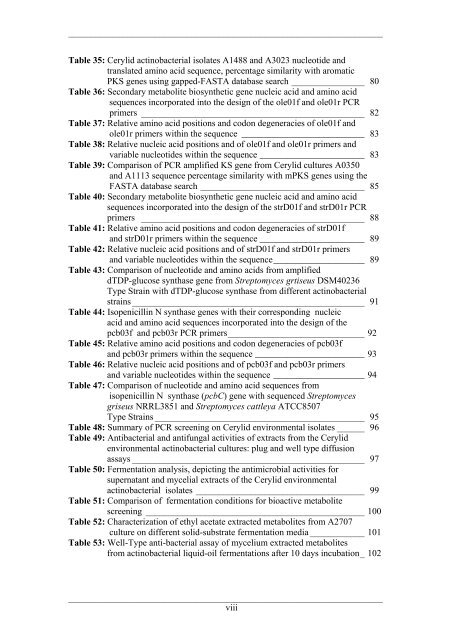Detection and Expression of Biosynthetic Genes in Actinobacteria ...
Detection and Expression of Biosynthetic Genes in Actinobacteria ...
Detection and Expression of Biosynthetic Genes in Actinobacteria ...
You also want an ePaper? Increase the reach of your titles
YUMPU automatically turns print PDFs into web optimized ePapers that Google loves.
_____________________________________________________________________Table 35: Cerylid act<strong>in</strong>obacterial isolates A1488 <strong>and</strong> A3023 nucleotide <strong>and</strong>translated am<strong>in</strong>o acid sequence, percentage similarity with aromaticPKS genes us<strong>in</strong>g gapped-FASTA database search ________________ 80Table 36: Secondary metabolite biosynthetic gene nucleic acid <strong>and</strong> am<strong>in</strong>o acidsequences <strong>in</strong>corporated <strong>in</strong>to the design <strong>of</strong> the ole01f <strong>and</strong> ole01r PCRprimers _________________________________________________ 82Table 37: Relative am<strong>in</strong>o acid positions <strong>and</strong> codon degeneracies <strong>of</strong> ole01f <strong>and</strong>ole01r primers with<strong>in</strong> the sequence ___________________________ 83Table 38: Relative nucleic acid positions <strong>and</strong> <strong>of</strong> ole01f <strong>and</strong> ole01r primers <strong>and</strong>variable nucleotides with<strong>in</strong> the sequence _______________________ 83Table 39: Comparison <strong>of</strong> PCR amplified KS gene from Cerylid cultures A0350<strong>and</strong> A1113 sequence percentage similarity with mPKS genes us<strong>in</strong>g theFASTA database search ____________________________________ 85Table 40: Secondary metabolite biosynthetic gene nucleic acid <strong>and</strong> am<strong>in</strong>o acidsequences <strong>in</strong>corporated <strong>in</strong>to the design <strong>of</strong> the strD01f <strong>and</strong> strD01r PCRprimers _________________________________________________ 88Table 41: Relative am<strong>in</strong>o acid positions <strong>and</strong> codon degeneracies <strong>of</strong> strD01f<strong>and</strong> strD01r primers with<strong>in</strong> the sequence _______________________ 89Table 42: Relative nucleic acid positions <strong>and</strong> <strong>of</strong> strD01f <strong>and</strong> strD01r primers<strong>and</strong> variable nucleotides with<strong>in</strong> the sequence____________________ 89Table 43: Comparison <strong>of</strong> nucleotide <strong>and</strong> am<strong>in</strong>o acids from amplifieddTDP-glucose synthase gene from Streptomyces grtiseus DSM40236Type Stra<strong>in</strong> with dTDP-glucose synthase from different act<strong>in</strong>obacterialstra<strong>in</strong>s ___________________________________________________ 91Table 44: Isopenicill<strong>in</strong> N synthase genes with their correspond<strong>in</strong>g nucleicacid <strong>and</strong> am<strong>in</strong>o acid sequences <strong>in</strong>corporated <strong>in</strong>to the design <strong>of</strong> thepcb03f <strong>and</strong> pcb03r PCR primers______________________________ 92Table 45: Relative am<strong>in</strong>o acid positions <strong>and</strong> codon degeneracies <strong>of</strong> pcb03f<strong>and</strong> pcb03r primers with<strong>in</strong> the sequence ________________________ 93Table 46: Relative nucleic acid positions <strong>and</strong> <strong>of</strong> pcb03f <strong>and</strong> pcb03r primers<strong>and</strong> variable nucleotides with<strong>in</strong> the sequence ____________________ 94Table 47: Comparison <strong>of</strong> nucleotide <strong>and</strong> am<strong>in</strong>o acid sequences fromisopenicill<strong>in</strong> N synthase (pcbC) gene with sequenced Streptomycesgriseus NRRL3851 <strong>and</strong> Streptomyces cattleya ATCC8507Type Stra<strong>in</strong>s ______________________________________________ 95Table 48: Summary <strong>of</strong> PCR screen<strong>in</strong>g on Cerylid environmental isolates ______ 96Table 49: Antibacterial <strong>and</strong> antifungal activities <strong>of</strong> extracts from the Cerylidenvironmental act<strong>in</strong>obacterial cultures: plug <strong>and</strong> well type diffusionassays ___________________________________________________ 97Table 50: Fermentation analysis, depict<strong>in</strong>g the antimicrobial activities forsupernatant <strong>and</strong> mycelial extracts <strong>of</strong> the Cerylid environmentalact<strong>in</strong>obacterial isolates _____________________________________ 99Table 51: Comparison <strong>of</strong> fermentation conditions for bioactive metabolitescreen<strong>in</strong>g ________________________________________________ 100Table 52: Characterization <strong>of</strong> ethyl acetate extracted metabolites from A2707culture on different solid-substrate fermentation media ____________ 101Table 53: Well-Type anti-bacterial assay <strong>of</strong> mycelium extracted metabolitesfrom act<strong>in</strong>obacterial liquid-oil fermentations after 10 days <strong>in</strong>cubation_ 102_____________________________________________________________________viii















